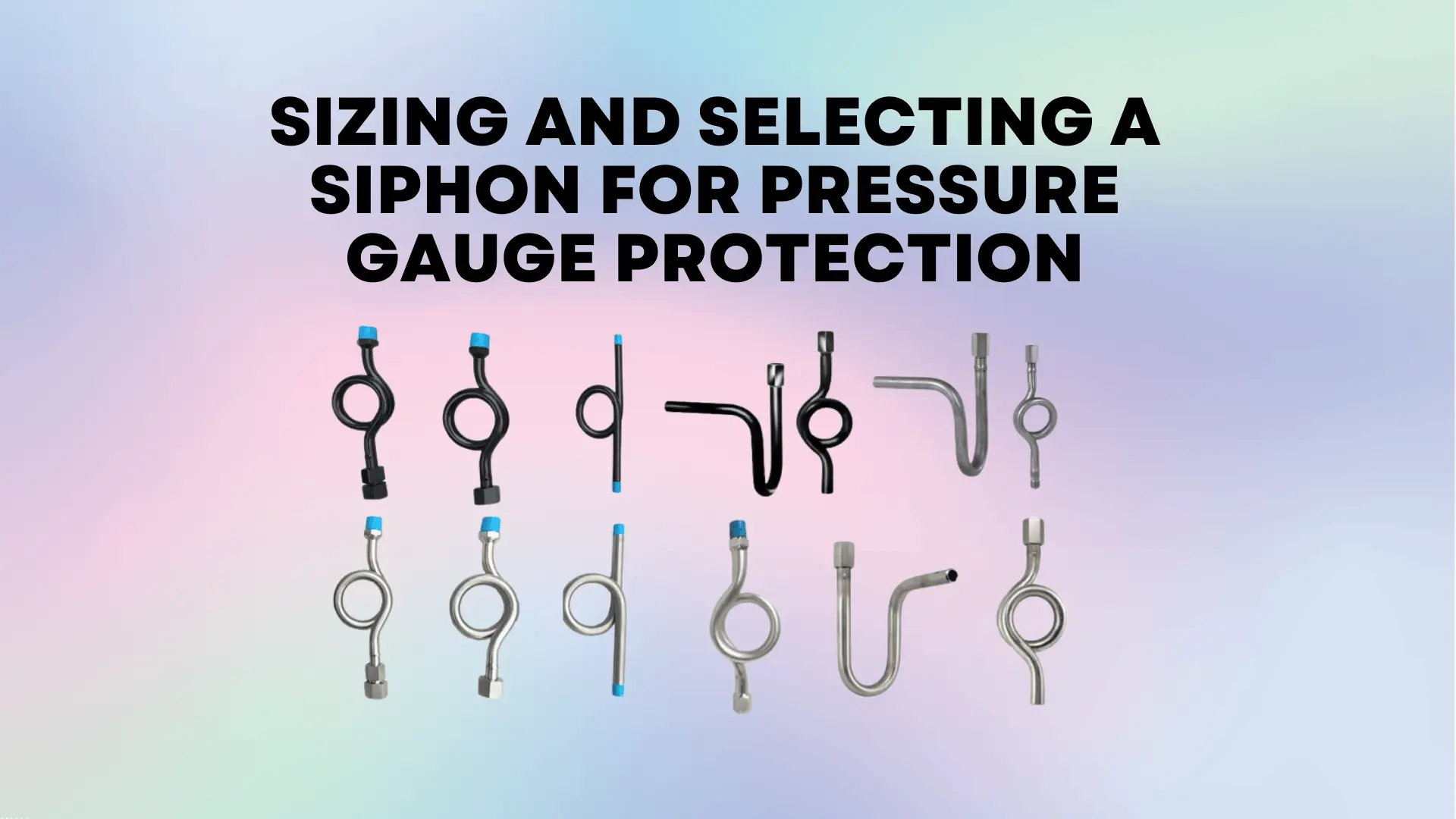Siphons are used in pressure measurement systems, especially in applications involving high-temperature fluids or steam.
They protect pressure gauges from direct exposure to extreme temperatures, thereby extending the lifespan and accuracy of the instruments.
This article explains the key considerations for sizing and selecting a siphon, with examples.
Table of Contents
ToggleWhy Use a Siphon in Pressure Measurement?
Siphons act as a barrier, preventing hot process media from coming into direct contact with the pressure gauge. They achieve this by:
- Allowing condensate to form, creating a thermal buffer.
- Protecting gauges from rapid temperature fluctuations.
- Reducing the risk of gauge failure due to overheating.
Typical applications include:
- Steam pressure measurement in boilers.
- High-temperature fluid systems in process industries.
Key Factors for Sizing a Siphon
When sizing a siphon, consider the following parameters:
1. Process Pressure
Ensure the siphon can withstand the operating pressure of the process. The material and design must align with the system’s maximum allowable working pressure (MAWP).
2. Process Temperature
Siphons are designed to dissipate heat effectively. The length, material, and geometry of the siphon influence its thermal dissipation capacity.
3. Fluid Characteristics
Determine if the process fluid is steam, gas, or liquid. This impacts the type of siphon (coil or pigtail) and its material selection.
4. Connection Standards
Match the siphon’s connections with the pressure gauge and the process line. Common standards include NPT, BSP, or flanged connections.
5. Material Compatibility
Select a siphon material compatible with the process fluid. Common materials include:
- Carbon Steel: For general industrial use.
- Stainless Steel: For corrosive environments.
- Brass: For low-pressure applications.
Steps to Select a Siphon
Step 1: Determine Operating Conditions
- Operating pressure: P_op
- Operating temperature: T_op
- Fluid type: Steam, gas, or liquid.
Step 2: Select Siphon Type
- Pigtail Siphon: Ideal for steam applications due to its compact design and excellent heat dissipation.
- Coil Siphon: Suitable for high-pressure systems and better thermal protection.
Step 3: Check Material and Pressure Ratings
Choose a material rated to handle the P_op and T_op of the system.
Step 4: Calculate Pressure Drop
Pressure drops across the siphon must be minimal to avoid affecting the gauge’s accuracy. Use the Darcy-Weisbach equation:
Delta_P = f (L / D) (rho * v2 / 2)
Where:
- Delta_P: Pressure drop (Pa)
- f: Friction factor (dimensionless)
- L: Siphon length (m)
- D: Inner diameter (m)
- rho: Fluid density (kg/m3)
- v: Fluid velocity (m/s)
Step 5: Verify Thermal Dissipation
Estimate the thermal dissipation capacity of the siphon using Fourier’s law of heat conduction:
Q = -k A (Delta_T / L)
Where:
- Q: Heat transfer rate (W)
- k: Thermal conductivity of siphon material (W/m*K)
- A: Cross-sectional area (m^2)
- Delta_T: Temperature difference (Celsius)
- L: Length of the siphon (m)
Step 6: Select Connection Size
Ensure the siphon’s inlet and outlet connections match the pressure gauge and process line fittings.
Example Calculation
Given:
- Operating pressure: P_op = 10 bar
- Operating temperature: T_op = 250 degrees Celsius
- Fluid: Steam
- Siphon material: Stainless steel (thermal conductivity k = 16 W/m*K)
- Inner diameter: D = 0.01 m
- Siphon length: L = 0.5 m
- Fluid velocity: v = 2 m/s
- Fluid density: rho = 2 kg/m3
Calculation
Pressure Drop: Using the Darcy-Weisbach equation:
Delta_P = f (L / D) (rho * v2 / 2)
Assuming friction factor f = 0.02:
Delta_P = 0.02 (0.5 / 0.01) (2 * (2)2 / 2) = 4 Pa
Heat Dissipation: Using Fourier’s law:
Q = -k A (Delta_T / L)
Cross-sectional area A = pi (D/2)2 = pi (0.01/2)2 = 7.85 x 10-5 m2.
Assuming temperature difference Delta_T = 100 degrees Celsius:
Q = -16 7.85 x 10-5 (100 / 0.5) = 0.251 W
Summary
Proper sizing and selection of a siphon are critical for ensuring accurate and reliable pressure gauge performance in high-temperature applications. By understanding operating conditions, calculating pressure drops, and verifying thermal dissipation, you can select the right siphon for your process. This not only enhances instrument longevity but also ensures process safety and efficiency.

